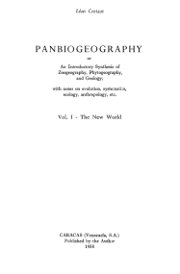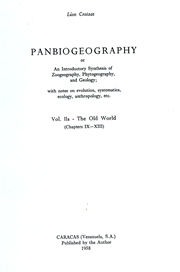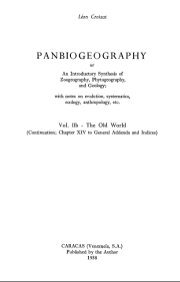Panbiogeography
CROIZAT, L. (1958). Panbiogeography. Published by the author, Caracas.
Volume I
- Introduction, pp. i-xxxi
- Chapter 1, pp. 1-73: What we need, where do we stand; and the main concepts
(chronology, mechanism of form-making, means of dispersal, etc.).
- Chapter 2, pp. 74-172: The "long end" of distribution, and what it means.
- Chapter 3, pp. 173-272: The Matthewian and Simpsonian doctrine of (mammalian)
dispersal.
- Chapter 4, pp. 273-363: A consideration of Venezuelan, Colombian, and
Ecuadorean dispersal I (i. The Cordillera de la Macarena. A study in
comprehensiveness 275; ii. The New World and the dispersal of Pipits (Aves;
Anthus) 309; iii. Why Barbets (Capitonidae) are not the Sierra de
Santa Marta 329; iv. On "Magdalenian" dispersal 348).
- Chapter 5, pp. 365-486: A consideration of Venezuelan, Colombian, and
Ecuadorean dispersal II (i. A study in the nature of disconnection 365;
ii. "Modern" dispersal and an ancient geosyncline 390; iii. Colinus
in Colombia, and notes in general on New World's dispersal 398;
iv. Distribution by the Nevado del Cocuy (Boyacá, in Colombia) 463).
- Chapter 6, pp. 487-601: A consideration of Venezuelan, Colombia, and
Ecuadorean dispersal III (i. Venezuelan endemism and Venezuelan distribution
in general 487; ii. Parrots in and around the Northern Andes and Peru 558;
iii. The dispersal of Mabuya and Matthew's Law 585).
- Chapter 7, pp. 602-745: Dispersal in and around the West Indies (i. Ameiva
and Cnemidophorus all over the islands and the main 635; ii. Crotalus
and the Caribbeans 644; iii. Fernando de Noronha to Revilla Gigedo and Nova
Scotia 653; Onycophora and their distribution 658; v. From Fernando de
Noronha westward once again 664; vi. The dispersal of Iguana 694;
vii. An analysis of constrasts; Dendroica petechia and Coereba
flaveola 696; viii. Mammalian dispersal in the Antilles 709;
ix. Antilles-Galapagos-New Zealand either way 720; x. The eel and its
"problem" 735).
- Chapter 8, pp. 746-859: Dispersal in and around Galapagos (i. Crowding in
Western Colombia 801; ii. From Malpelo to San Félix, San Ambrosio, and
Galapagos again 805; iii. Caribbean-Pacific interplays 809; iv. "Genus"
Eribates and genus Nesotriccus 816; v. Cuckoos on and around
Galapagos 819; vi. Gekkos as master-biogeographers; Phyllodactyus on
Galapagos 823; vii. Why no woodpeckers (Picidae) are in Galapagos? 827;
viii. The sea-crabs of Galapagos 841; ix. Galapagos and its very own
"Darwin's Finches", with notes on Hawaii, generally 843).
Addendum I, pp. 859-861: [Turrill's opinion of Galapagos "phytogeography".]
General Addenda, pp. 862-941: 862 [Notes on the Egido-Estanquez sector of
Mérida, Venezuela]; 863 [Notes on the descent of Andes nevados during
the Pleistocene] 864 [Notes on the ecology and biogeography of the
cavernicolous fauna of the Savona district of Northwestern Italy];
868 [Notes on the botanical family Dioncophyllaceae and its allies];
873 [Notes on Shinisaurus]; 873 [Notes on the Tupaioidea]; 874
[Notes on Simpson's "Tempo and Mode in Evolution"]; 876 [Notes on South
American centers of mammalian life]; 877 [Notes on Lasser's "ecology" of
Venezuela]; 885 [Notes on Mayr's "zoogeography" of the Amazon Basin];
890 [Notes on Homo, and the butterflies Zygaenidae]; 905 [Notes on
the dispersal by the Venezuelan Islands]; 906 [Notes on crayfish (Crustacea
Decapoda Macrura) dispersal]; 915 [Notes on the "stratospheric conveyance of
seeds", and the orchids of the East African Islands in particular]; 924
[Notes on the dispersal of the fern Doryopteris in the New World];
936 [Comparative notes on the floras of Cocos Island and the Galapagos
Archipelago]; 939 [Notes on Commerson as a biogeographer].
- Bibliography, pp. 942-961.
- Indices, pp. 963-1018.
A) Volume IIA
- Chapter IX, pp. 1-84: Africa and its main biogeographic connections
(i. Testudo in general, and in the East African Islands especially
63; ii. The Madagascar "rats" 69; iii. On certain aspects of Francolinus
dispersal 74).
- Addendum I, pp. 85-90: [On the close relationships of sylviid birds between
Tropical Africa and Tropical America "across the Atlantic"].
- Addendum II, pp. 91-96: [On the flora of Southern South Africa and its
connections].
- Addendum III, pp. 97-181: The "Tanganyka Problem" of the conchologist, and
where this "Problem" leads with fishes, jellyfishes, shrimps, cotton
(Gossypium), maize (Zea), cockroaches, rats, pigs and
butterflies, etc.
- Chapter X, pp. 183-326: The prime movers of Eurasian biogeography. I.
(i. Central Asia in dispersal; An introduction to the subject 202; ii. Which
way to the Altai Center? 220; iii. The ancient Asia coigns in
dispersal 228; iv. Pre-glacial and post-glacial distribution 232; v. The Motacilla
flavissima/lutea/taivana conundrum 265; vi. A biogeographic picnic;
Tanganyka to Senegambia, Scandinavia, Japan, the Phillipines and Eastern Lesser Sunda,
Alaska, Florida, Panama, Chile, Southern Argentina 261; vii. The tree-frog (Hyla)
mystery 288; viii. On what takes place among the Tarbagatai, Nilghiris and Mount Kinabalu
302; ix. How old are "sibling" species? 315.
- Chapter XI, pp. 327-451: The prime movers of Eurasian biogeography. II. (i. The sibling
swallows, Hirundo daurica and H. striolata 327; ii. On "Palaeartic" Larks
(Alauda) 331; iii. Eumeces' two massings 335; iv. Odds and ends between the
Bay of Bengal and the South China Sea I. 338; v. Odds and ends between the Bay of Bengal
and the South China Sea II. 382; vi. All within the triangle; Madagascar - Moluccas -
Hokkaido 398; vii. On some peculiarities of Japanese dispersal 411; viii. Back to Europe
and its dispersal 435).
- Chapter XII, pp. 452-637: Dispersal in Malaysia and Australasia. I. (i. Bearings from
snake-life 470; ii. "Broad" Malaysian and Australasian dispersal 484; iii. The "Two Trerons"
conundrum 512; iv. A tale of Ceyx, or "good species" hybridizing 50% over 523;
v. The biogeography of insignificant geography 530; vi. The mammals and Wallace's Line
554; vii. The Pisonia grandis "mystery" 593; viii. Closing on New Guinea 597;
ix. On to New Guinea out of the Ceram - Banda - Arafura seas 616).
- Chapter XIII, pp. 638-771: Dispersal in Malaysia and Australasia. II. (i. Notes on New Guinea
"panbiogeography" 638; ii. Disconnections in New Guinea 681; iii. On "Nongeographic Speciation"
in general, and in New Guinea in particular 691; iv. Slicing up the Western Pacific 721;
v. Biogeography on the quick; Hystrix vs. Drimys 729; vi. The run of Lalage
743; vii. The run of Phalanger and Monotremata 756).
B) Volume IIB
- Chapter XIV, pp. 772-985: Dispersal in Central to Eastern Polynesia (i. From Flores to Tahiti
in general 775; ii. The biogeography of Central and Eastern Polynesia in particular 828).
- Chapter XV, pp. 986-1020e: The Conclusions.
- Chapter XVI, pp. 1021-1083: An Epilogue: On "Lamarckism", "Darwinism", "Neo-Darwinism",
dicenda atque tacenda.
- Addendum [to Chapter XVI], pp. 1084-1161b: On Physical Anthropology, that is, Blood-Types vs.
Calipers.
- General Addenda, pp. 1162-1640: 1162 [Notes on dispersal in the Sudan]; 1169 [Notes on living and
fossil dispersal in and around Madagascar with remarks on Hippopotamus]; 1177 [Notes on
Wegener's Theory]; 1178 [Notes on the nexus between biogeography and classification];
1180 [Notes on genetic powers]; 1183 [Notes on plant-phylogeny, and dispersal]; 1184 [Notes on
the contrasting American dispersal of Osteoglossid fishes]; [Notes on the dispersal of Eurylaimid
birds]; 1194 [Notes on the dispersal centering between Tenasserim and the Greater Sunda]; 1194
[Notes on Wallacea and "zoogeographic waves"]; 1195 [Notes on "alpine" plant-life mostly
in Malaysia, and observations on means of dispersal vs. means of survival]; 1290
[Notes on "insular" dispersal]; 1211 [Two notes on New Guinea dispersal in general]; 1213 [Notes on
the dispersal and form-making of the vegetation of mountains in general and the Andes in particular];
1224 [Notes on "convergence", "resemblance", etc.]; 1227 [Notes on the dispersal of certain Columbid
birds in Malaysia and Australasia]; 1247 [Notes on the dispersal of the parrots Aprosmictus
and Alisterus]; 1249 [Notes on dispersal in and around the Moluccas]; 1258 [Notes on the
interplay of biogeography and ecology]; 1259 [Notes on the dispersal of certain Anatidae and
"vicariism"]; 1264 [Notes on a presumed new euphorbiaceous genus "Croizatia", and certain
ancient "tracks" of Venezuela]; 1268 [Notes on Homo's "ascent"]; 1307 [Notes on Homo
in Siberia and, generally, Asia and both sides of the Pacific]; 1380 [Notes on the dispersal of the
lamellibranch genus Acila living and fossil, and on biostratigraphy]; 1387 [Notes on the dispersal
and form-making of the Nepenthaceae]; 1409 [Notes on the dispersal of the saxifragaceous genus
Chryosplenium and on dispersal in the north generally]; 1567 [Notes on Rivet's book Les Origines
de l'Homme Américain. 1957, and on certain aspects of the tenets of Theilhard de Chardin and Lack];
1609 [Notes on the dispersal of the mammalian faunas of South America]; 1609 [Notes on the dispersal of
Jurassic marine shells]; 1611 [Notes on the geology of oil (petroleum) and its nexus with dispersal];
1613 [Notes on Darlington's book Zoogeography The Geographical Distribution of Animals. 1957];
1627 [Notes on Good's book Features of Evolution in the Flowering Plants. 1956]; 1630 [Notes on
Andrewartha & Birch's book The Distribution and Abundance of Animals. 1954]; 1634 [Notes on
Montadon's book La Civilisation Ainou et les Cultures Arctiques. 1937]; 1638 [Notes on Clark's
book L'Europe Préhistorique Les Fondements de son Economie. 1955 (French version)].
- Bibliography, pp. 1641-1655.
- Indices, pp. 1656-1731.
 Download Vol. I Download Vol. I
 Download Vol. IIa Download Vol. IIa
 Download Vol. IIb Download Vol. IIb
|

